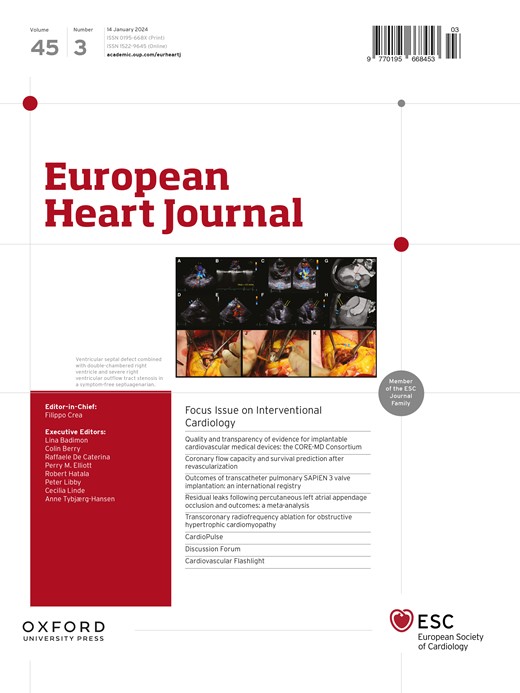Left bundle branch area pacing vs right ventricular pacing for atrioventricular block: the MELOS RELOADED study.
IF 35.6
1区 医学
Q1 CARDIAC & CARDIOVASCULAR SYSTEMS
引用次数: 0
Abstract
BACKGROUND AND AIMS Left bundle branch area pacing (LBBAP) promotes physiological synchronous activation of the left ventricle and may be particularly beneficial in patients with atrioventricular block (AVB), but its mortality benefit remains unclear. This study aims to compare long-term survival in AVB patients receiving either LBBAP or right ventricular pacing (RVP) and to analyse predictors of mortality during LBBAP. METHODS MELOS RELOADED, a multicentre European collaboration, was a registry-based study of pacemaker patients with AVB, left ventricular ejection fraction (LVEF) >40% and ventricular pacing >20%. The primary outcome was all-cause mortality based on national registries. A 1:1 propensity score matching was performed between the RVP and LBBAP groups. Kaplan-Meier curves and multivariable Cox proportional hazards models were used to estimate survival. RESULTS In total, 3382 patients receiving LBBAP or RVP were matched. At 4-year follow-up, the Kaplan-Meier curve showed an absolute difference in survival of 11.8% in favour of LBBAP (P < .001). LBBAP was a robust predictor of reduced mortality with a hazard ratio (HR) of 0.53 (95% confidence interval 0.42-0.65, P < .001). Within the LBBAP group, the following independent predictors of increased mortality were identified: lack of confirmed left bundle branch capture (HR 1.85, P < .001), lower percentage of ventricular pacing (HR 1.12), and age. CONCLUSIONS This is the first large study demonstrating the long-term survival benefit of LBBAP. This strengthens the use of LBBAP in AVB patients with preserved/mildly reduced LVEF while awaiting the results of randomized trials. Confirmation of left bundle branch capture seems advisable to achieve optimal results with LBBAP.左束分支区起搏vs右心室起搏治疗房室传导阻滞:MELOS RELOADED研究
背景和目的左束分支区域起搏(LBBAP)促进左心室的生理同步激活,可能对房室传导阻滞(AVB)患者特别有益,但其死亡率效益尚不清楚。本研究旨在比较接受LBBAP或右心室起搏(RVP)的AVB患者的长期生存率,并分析LBBAP期间死亡率的预测因素。欧洲多中心合作项目smelos RELOADED是一项基于注册的研究,研究对象为AVB起搏器患者,左室射血分数(LVEF) >为40%,心室起搏>为20%。主要结局是基于国家登记的全因死亡率。在RVP组和LBBAP组之间进行1:1的倾向评分匹配。Kaplan-Meier曲线和多变量Cox比例风险模型用于估计生存率。结果共匹配3382例接受LBBAP或RVP治疗的患者。在4年的随访中,Kaplan-Meier曲线显示LBBAP患者的绝对生存差异为11.8% (P < 0.001)。LBBAP是降低死亡率的可靠预测因子,危险比(HR)为0.53(95%可信区间0.42-0.65,P < 0.001)。在LBBAP组中,确定了以下死亡率增加的独立预测因素:缺乏确认的左束分支捕获(HR 1.85, P < 0.001),较低的心室起搏百分比(HR 1.12)和年龄。这是第一个证明LBBAP长期生存益处的大型研究。这加强了LBBAP在等待随机试验结果的保留/轻度降低LVEF的AVB患者中的应用。确认左束分支捕获对于LBBAP获得最佳结果似乎是可取的。
本文章由计算机程序翻译,如有差异,请以英文原文为准。
求助全文
约1分钟内获得全文
求助全文
来源期刊

European Heart Journal
医学-心血管系统
CiteScore
39.30
自引率
6.90%
发文量
3942
审稿时长
1 months
期刊介绍:
The European Heart Journal is a renowned international journal that focuses on cardiovascular medicine. It is published weekly and is the official journal of the European Society of Cardiology. This peer-reviewed journal is committed to publishing high-quality clinical and scientific material pertaining to all aspects of cardiovascular medicine. It covers a diverse range of topics including research findings, technical evaluations, and reviews. Moreover, the journal serves as a platform for the exchange of information and discussions on various aspects of cardiovascular medicine, including educational matters.
In addition to original papers on cardiovascular medicine and surgery, the European Heart Journal also presents reviews, clinical perspectives, ESC Guidelines, and editorial articles that highlight recent advancements in cardiology. Additionally, the journal actively encourages readers to share their thoughts and opinions through correspondence.
 求助内容:
求助内容: 应助结果提醒方式:
应助结果提醒方式:


